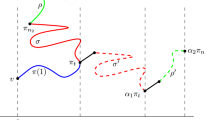Abstract
We give an elementary new method for obtaining rigorous lower bounds on the connective constant for self-avoiding walks on the hypercubic lattice ℤd. The method is based on loop erasure and restoration, and does not require exact enumeration data. Our bounds are best for highd, and in fact agree with the first four terms of the 1/d expansion for the connective constant. The bounds are the best to date for dimensionsd⩾ 3, but do not produce good results in two dimensions. Ford=3, 4, 5, and 6, respectively, our lower bound is within 2.4%, 0.43%, 0.12%, and 0.044% of the value estimated by series extrapolation.
Similar content being viewed by others
References
J. M. Hammersley and K. W. Morton, Poor man's Monte Carlo,J. Roy. Stat. Soc. B 16:23–38 (1954).
A. J. Guttmann, Bounds on connective constants for self-avoiding walks,J. Phys. A: Math. Gen. 16:2233–2238 (1983).
T. Hara and G. Slade, Self-avoiding walk in five or more dimensions. I. The critical behaviour,Commun. Math. Phys. 147:101–136 (1992).
T. Hara and G. Slade, The lace expansion for self-avoiding walk in five or more dimensions,Rev. Math. Phys. 4:235–327 (1992).
A. R. Conway and A. J. Guttmann, Lower bound on the connective constant for square lattice self-avoiding walks, preprint (1992).
S. E. Alm, Upper bounds for the connective constant of self-avoiding walks, Preprint (1992), to appear inCombinatorics, Probability and Computing.
A. J. Guttmann and I. G. Enting, The size and number of rings on the square lattice,J. Phys. A: Math. Gen. 21:L165–L172 (1988).
A. R. Conway, I. G. Enting, and A. J. Guttmann, Algebraic techniques for enumerating self-avoiding walks on the square lattice,J. Phys. A: Math. Gen. 26:1519–1534 (1993).
A. J. Guttmann, Private communication.
A. J. Guttmann, On the zero-field susceptibility in thed=4,n=0 limit: Analysing for confluent logarithmic singularities,J. Phys. A: Math. Gen. 11:L103–L106 (1978).
A. J. Guttmann, Correction to scaling exponents and critical properties of then-vector model with dimensionality > 4,J. Phys. A: Math. Gen. 14:233–239 (1981).
T. Hara and G. Slade, The self-avoiding walk and percolation critical points in high dimensions, In preparation.
N. Madras and G. Slade,The Self-Avoiding Walk (Birkhäuser, Boston, 1993).
M. E. Fisher and M. F. Sykes, Excluded-volume problem and the Ising model of ferromagnetism,Phys. Rev. 114:45–58 (1959).
F. Spitzer,Principles of Random Walk, 2nd ed. (Springer, New York, 1976).
G. F. Lawler,Intersections of Random Walks (Birkhäuser, Boston, 1991).
C. Domb and M. E. Fisher, On random walks with restricted reversals,Proc. Camb. Philos. Soc. 54:48–59 (1958).
J. M. Hammersley, The number of polygons on a lattice,Proc. Camb. Philos. Soc. 57:516–523 (1961).
J. M. Hammersley and D. J. A. Welsh, Further results on the rate of convergence to the connective constant of the hypercubical lattice,Q. J. Math. Oxford (2) 13:108–110 (1962).
H. Kesten, On the number of self-avoiding walks. II,J. Math. Phys. 5:1128–1137 (1964).
M. E. Fisher, Critical temperatures of anisotropic Ising lattices. II. General upper bounds,Phys. Rev. 162:480–485 (1967).
J. Fröhlich, B. Simon, and T. Spencer, Infrared bounds, phase transitions, and continuous symmetry breaking,Commun. Math. Phys. 50:79–95 (1976).
G. F. Lawler, A connective constant for loop-erased self-avoiding random walk,J. Appl. Prob. 20:264–276 (1983).
A. M. Ferrenberg and D. P. Landau, Critical behavior of the three-dimensional Ising model: A high resolution Monte Carlo study,Phys. Rev. B 44:5081–5091 (1991).
D. S. Gaunt, M. F. Sykes, and S. McKenzie, Susceptibility and fourth-field derivative of the spin-1/2 Ising model forT> Tc andd=4,J. Phys. A: Math. Gen. 12:871–877 (1979).
M. E. Fisher and D. S. Gaunt, Ising model and self-avoiding walks on hypercubical lattices and “high-density” expansions,Phys. Rev. 133:A224–A239 (1964).
A. M. Nemirovsky, K. F. Freed, T. Ishinabe, and J. F. Douglas, Marriage of exact enumeration and 1/d expansion methods: Lattice model of dilute polymers,J. Stat. Phys. 67:1083–1108 (1992).
B. C. Rennie, Random walks,Magyar Tud. Akad. Mat. Kut. Int. Kozlemen A 6:263–269 (1961).
J. M. Hammersley, Long chain polymers and self-avoiding random walks,Sankhya 25A:29–38 (1963).
T. Hara, Mean field critical behaviour for correlation length for percolation in high dimensions,Prob. Theory Rel. Fields 86:337–385 (1990).
Author information
Authors and Affiliations
Rights and permissions
About this article
Cite this article
Hara, T., Slade, G. & Sokal, A.D. New lower bounds on the self-avoiding-walk connective constant. J Stat Phys 72, 479–517 (1993). https://doi.org/10.1007/BF01048021
Received:
Issue Date:
DOI: https://doi.org/10.1007/BF01048021




